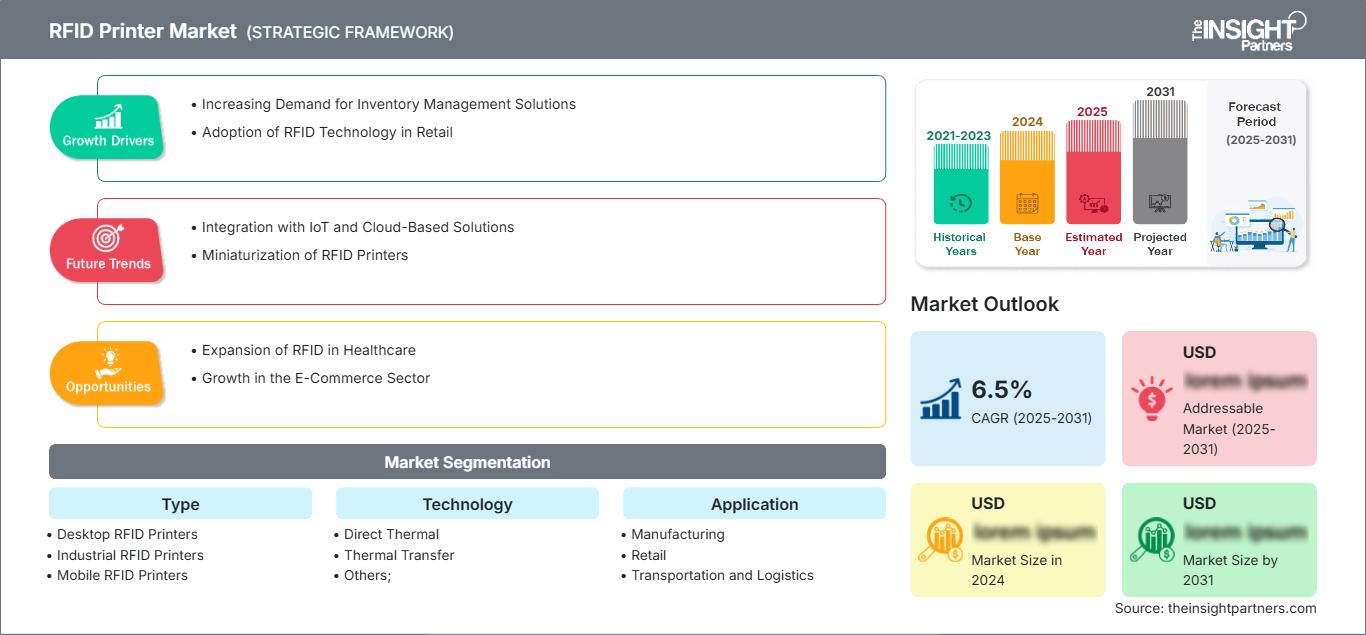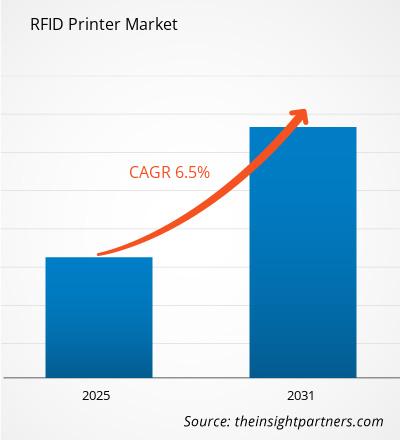Le marché des imprimantes RFID devrait enregistrer un TCAC de 6,5 % de 2025 à 2031, avec une taille de marché passant de XX millions de dollars américains en 2024 à XX millions de dollars américains d'ici 2031.
Le marché des imprimantes RFID couvre l'analyse par type (imprimantes RFID de bureau, imprimantes RFID industrielles, imprimantes RFID mobiles, autres) ; technologie (thermique directe, transfert thermique, autres) ; application (fabrication, vente au détail, transport et logistique, soins de santé, gouvernement, divertissement, autres) et géographie (Amérique du Nord, Europe, Asie-Pacifique, Moyen-Orient et Afrique, et Amérique du Sud et centrale)
Objectif du rapport
Le rapport sur le marché des imprimantes RFID de The Insight Partners vise à décrire le paysage actuel et la croissance future, les principaux facteurs moteurs, les défis et les opportunités. Cela fournira des informations à diverses parties prenantes commerciales, telles que :
- Fournisseurs/fabricants de technologie : pour comprendre l’évolution de la dynamique du marché et connaître les opportunités de croissance potentielles, leur permettant de prendre des décisions stratégiques éclairées.
- Investisseurs : pour effectuer une analyse complète des tendances concernant le taux de croissance du marché, les projections financières du marché et les opportunités qui existent tout au long de la chaîne de valeur.
- Organismes de réglementation : pour réglementer les politiques et surveiller les activités du marché dans le but de minimiser les abus, de préserver la confiance des investisseurs et de maintenir l’intégrité et la stabilité du marché.
Segmentation du marché des imprimantes RFID
- Imprimantes RFID de bureau
- Imprimantes RFID industrielles
- Imprimantes RFID mobiles
- Autres ;
Technologie
- Thermique directe
- Transfert thermique
- Autres ;
Application
- Fabrication
- Vente au détail
- Transport et logistique
- Santé
- Gouvernement
- Divertissement
- Autres
Géographie
- Amérique du Nord
- Europe
- Asie-Pacifique
- Amérique du Sud et centrale
- Moyen-Orient et Afrique
Vous bénéficierez d’une personnalisation sur n’importe quel rapport - gratuitement - y compris des parties de ce rapport, ou une analyse au niveau du pays, un pack de données Excel, ainsi que de profiter d’offres exceptionnelles et de réductions pour les start-ups et les universités
Marché des imprimantes RFID: Perspectives stratégiques

-
Obtenez les principales tendances clés du marché de ce rapport.Cet échantillon GRATUIT comprendra une analyse de données, allant des tendances du marché aux estimations et prévisions.
Facteurs de croissance du marché des imprimantes RFID
- Demande croissante de solutions de gestion des stocks : Le besoin croissant d'un suivi efficace des stocks et d'une gestion efficace de la chaîne d'approvisionnement stimule le marché des imprimantes RFID. Les imprimantes RFID permettent aux entreprises de générer facilement des étiquettes RFID pour l'identification des produits, améliorant ainsi la gestion des actifs, réduisant les erreurs humaines et améliorant la visibilité des stocks en temps réel. Cette demande est particulièrement élevée dans des secteurs comme la vente au détail, la logistique et la fabrication.
- Adoption de la technologie RFID dans le commerce de détail : Les détaillants adoptent de plus en plus la technologie RFID pour optimiser leurs opérations, améliorer l'expérience client et réduire les pertes. Les imprimantes RFID sont essentielles pour imprimer les étiquettes RFID utilisées dans les environnements de vente au détail pour le contrôle des stocks, le suivi des actifs et les services clients personnalisés. La tendance croissante à l'automatisation et au commerce intelligent est un moteur important du marché des imprimantes RFID.
Tendances futures du marché des imprimantes RFID
- Intégration avec l'IoT et les solutions cloud : une tendance clé sur le marché des imprimantes RFID est l'intégration des imprimantes RFID avec l'Internet des objets (IoT) et les systèmes cloud. Ces systèmes permettent un partage de données transparent, un suivi en temps réel et une surveillance à distance des étiquettes RFID. L'importance croissante du cloud computing et des appareils connectés dans la chaîne d'approvisionnement et la gestion des actifs alimente cette tendance.
- Miniaturisation des imprimantes RFID : la tendance est à la miniaturisation des imprimantes RFID. Les imprimantes RFID compactes et portables sont de plus en plus populaires, en particulier pour les entreprises qui ont besoin de solutions d'impression mobiles sur le terrain. Ces imprimantes compactes et conviviales sont idéales pour les applications dans le commerce de détail, la santé et la logistique, où la portabilité et la facilité d'utilisation sont importantes.
Opportunités de marché des imprimantes RFID
- Expansion de la RFID dans le secteur de la santé : Le secteur de la santé représente une opportunité de croissance significative pour les imprimantes RFID. La technologie RFID est de plus en plus utilisée pour le suivi des patients, la gestion des médicaments et la surveillance des actifs. Les imprimantes RFID sont essentielles pour générer des bracelets pour patients, des étiquettes de médicaments et des étiquettes d'équipement, offrant des opportunités de croissance substantielles dans ce secteur, notamment avec l'adoption croissante des solutions de santé basées sur la RFID.
- Croissance dans le secteur du e-commerce : L'expansion du e-commerce et de la vente en ligne offre aux imprimantes RFID l'opportunité de jouer un rôle clé dans la logistique et la gestion des stocks. Les plateformes de e-commerce nécessitant un suivi et une expédition des produits en temps réel, les imprimantes RFID peuvent être utilisées pour créer des étiquettes pour les colis, garantissant des délais de traitement plus rapides, réduisant les erreurs humaines et améliorant la visibilité de la chaîne d'approvisionnement.
Marché des imprimantes RFID
Les tendances et facteurs régionaux influençant le marché des imprimantes RFID tout au long de la période de prévision ont été analysés en détail par les analystes de The Insight Partners. Cette section aborde également les segments et la répartition géographique du marché des imprimantes RFID en Amérique du Nord, en Europe, en Asie-Pacifique, au Moyen-Orient et en Afrique, ainsi qu'en Amérique du Sud et en Amérique centrale.
Portée du rapport sur le marché des imprimantes RFID| Attribut de rapport | Détails |
|---|---|
| Taille du marché en 2024 | US$ XX million |
| Taille du marché par 2031 | US$ XX Million |
| TCAC mondial (2025 - 2031) | 6.5% |
| Données historiques | 2021-2023 |
| Période de prévision | 2025-2031 |
| Segments couverts |
By Type
|
| Régions et pays couverts |
Amérique du Nord
|
| Leaders du marché et profils d'entreprises clés |
|
Densité des acteurs du marché des imprimantes RFID : comprendre son impact sur la dynamique des entreprises
Le marché des imprimantes RFID connaît une croissance rapide, portée par une demande croissante des utilisateurs finaux, due à des facteurs tels que l'évolution des préférences des consommateurs, les avancées technologiques et une meilleure connaissance des avantages du produit. Face à cette demande croissante, les entreprises élargissent leur offre, innovent pour répondre aux besoins des consommateurs et capitalisent sur les nouvelles tendances, ce qui alimente la croissance du marché.
- Obtenez le Marché des imprimantes RFID Aperçu des principaux acteurs clés
Principaux arguments de vente
- Couverture exhaustive : Le rapport couvre l’analyse exhaustive des produits, services, types et utilisateurs finaux du marché des imprimantes RFID, offrant un panorama global.
- Analyse d’experts : Le rapport est élaboré à partir d’une compréhension approfondie des experts et analystes du secteur.
- Informations actualisées : Le rapport garantit la pertinence commerciale grâce à sa couverture des informations récentes et des tendances des données.
- Options de personnalisation : Ce rapport peut être personnalisé pour répondre aux besoins spécifiques des clients et s’adapter aux stratégies commerciales.
Le rapport de recherche sur le marché des imprimantes RFID peut donc contribuer à la compréhension du marché et des perspectives de croissance. Malgré quelques préoccupations légitimes, les avantages globaux de ce rapport tendent à l’emporter sur les inconvénients.
- Analyse historique (2 ans), année de base, prévision (7 ans) avec TCAC
- Analyse PEST et SWOT
- Taille du marché Valeur / Volume - Mondial, Régional, Pays
- Industrie et paysage concurrentiel
- Ensemble de données Excel
Rapports récents
Témoignages
Raison d'acheter
- Prise de décision éclairée
- Compréhension de la dynamique du marché
- Analyse concurrentielle
- Connaissances clients
- Prévisions de marché
- Atténuation des risques
- Planification stratégique
- Justification des investissements
- Identification des marchés émergents
- Amélioration des stratégies marketing
- Amélioration de l'efficacité opérationnelle
- Alignement sur les tendances réglementaires






















 Obtenez un échantillon gratuit pour - Marché des imprimantes RFID
Obtenez un échantillon gratuit pour - Marché des imprimantes RFID